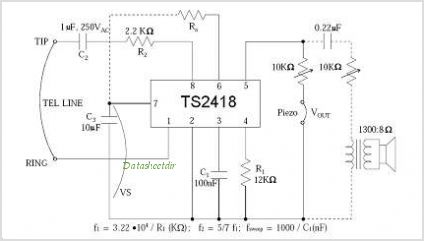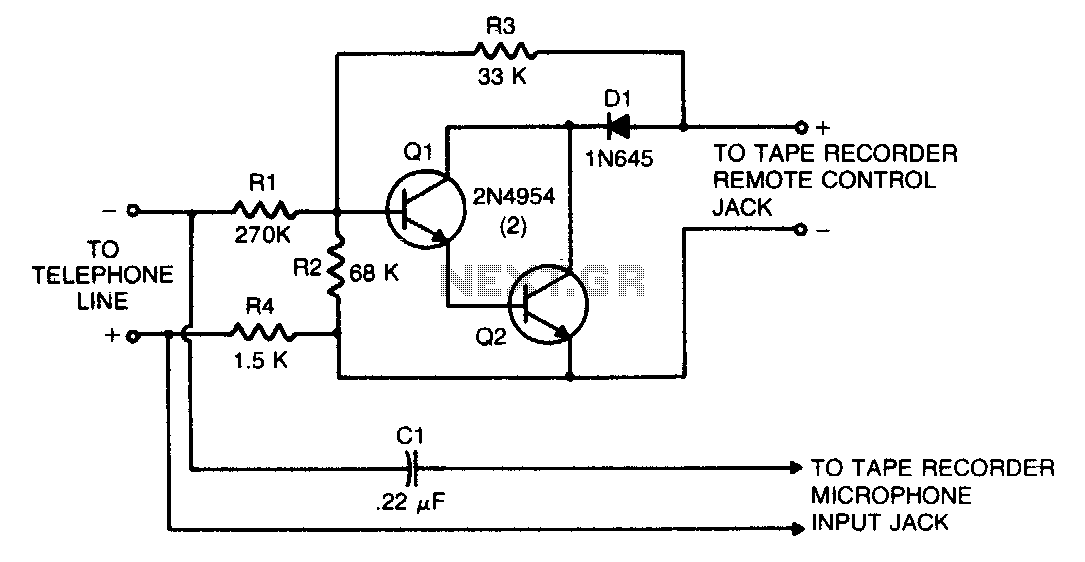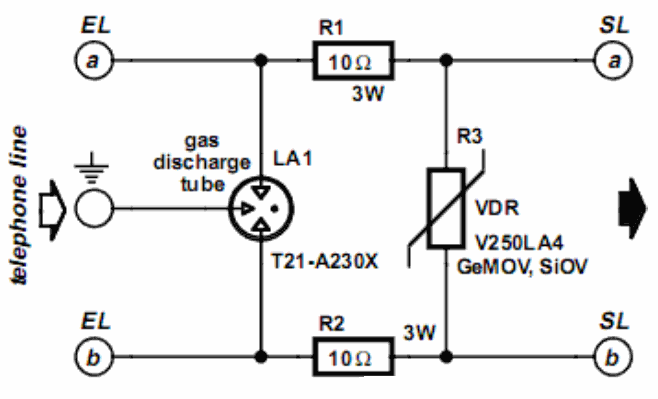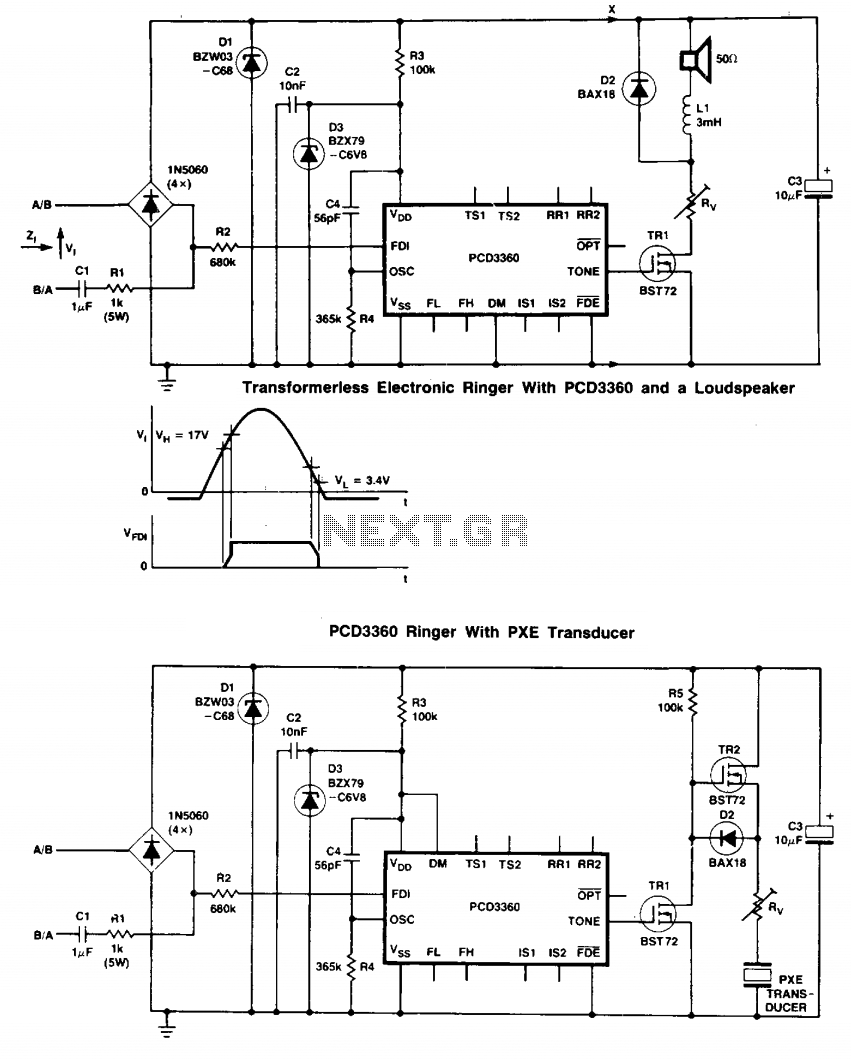
Telephone Toll Totalizer

The Telephone Totalizer is built around two 4518 dual synchronous up counters, a 74C925 4-digit counter, a 458 hex inverting buffer, and a 4081 quad 2-input AND gate. It is designed to estimate toll charges by calculating the time spent on a telephone call. The counter starts when dialing begins and is manually stopped upon hang-up. By calibrating the device to reflect the average cost per second of calls, which can be derived from the user's monthly phone bill, it provides a close estimation of the phone bill. The circuit features an oscillator operating at a frequency of 100,000 Hz connected to the main counter (74C925). Typical telephone call costs range from 15 to 25 cents per minute, which positions the clock frequency (U1) within the 25 to 40 kHz range. The components U2 and U4, along with gates U3, create a counter that approximates 100,000. The estimated cost in dollars and cents is displayed on the multiplexed display units DISP 1, 2, and 3. A reset switch (S2) is included to clear the counter to zero after each use.
The Telephone Totalizer circuit is designed for ease of use and accuracy in monitoring telephone expenses. The two 4518 dual synchronous up counters facilitate the counting of pulses generated by the oscillator, which reflects the duration of the call. The 74C925 counter serves as the primary counting mechanism, capable of displaying up to four digits, thus allowing for a comprehensive readout of the calculated cost.
The oscillator, operating at a frequency of 100 kHz, generates pulse signals that are fed into the 74C925 counter. This high frequency ensures that the counting mechanism is responsive and accurate, providing real-time feedback on call duration. The typical cost of telephone calls, ranging from 15 to 25 cents per minute, necessitates the use of a clock frequency that aligns with these rates to ensure the calculations remain relevant.
The hex inverting buffer (458) is utilized to ensure that the signals are appropriately conditioned before being processed by the counters. Additionally, the quad 2-input AND gate (4081) plays a crucial role in controlling the flow of signals within the circuit, allowing for precise counting and display operations.
The multiplexed display (DISP 1, 2, 3) is designed to present the calculated cost in a user-friendly manner, allowing users to easily read their estimated telephone charges. The inclusion of a reset switch (S2) provides a simple method for users to clear the previous count, enabling them to start fresh for each new call session.
Overall, the Telephone Totalizer circuit combines various electronic components to create a functional and efficient tool for estimating telephone costs, making it a valuable addition for users looking to monitor their phone expenses accurately. The Telephone Totalizer built around two 4 518 dual synchronous up counters, a 74C925 4-digit counter, a 4 58 4 hex inverting buffer, and a 4 081 quad 2-input AND gate—is fairly simple. Approximate toll charges can be calculated with this counter. It is started when dialing and stopped (manually) on hang-up. It is actually a counter that measures the time you are on the telephone. By calibrating it to the average cost/second of calls (get this from calculations you have done on your monthly phone bill), you can closely estimate your phone bill. The circuit consists of an oscillator running at the 100 000 frequency into the main counter (74C925).
Typically, cost of telephone calls is 15 to 25 cents/minute so that the clock frequency (Ul) is in the 25- to 40-kHz range. U2 and U4 with gates U3 form a ~ 100000 counter. The approximate cost in dollars and cents is read out on the multiplexed display, DISP 1, 2, 3. S2 resets the counter to zero after each use.
The Telephone Totalizer circuit is designed for ease of use and accuracy in monitoring telephone expenses. The two 4518 dual synchronous up counters facilitate the counting of pulses generated by the oscillator, which reflects the duration of the call. The 74C925 counter serves as the primary counting mechanism, capable of displaying up to four digits, thus allowing for a comprehensive readout of the calculated cost.
The oscillator, operating at a frequency of 100 kHz, generates pulse signals that are fed into the 74C925 counter. This high frequency ensures that the counting mechanism is responsive and accurate, providing real-time feedback on call duration. The typical cost of telephone calls, ranging from 15 to 25 cents per minute, necessitates the use of a clock frequency that aligns with these rates to ensure the calculations remain relevant.
The hex inverting buffer (458) is utilized to ensure that the signals are appropriately conditioned before being processed by the counters. Additionally, the quad 2-input AND gate (4081) plays a crucial role in controlling the flow of signals within the circuit, allowing for precise counting and display operations.
The multiplexed display (DISP 1, 2, 3) is designed to present the calculated cost in a user-friendly manner, allowing users to easily read their estimated telephone charges. The inclusion of a reset switch (S2) provides a simple method for users to clear the previous count, enabling them to start fresh for each new call session.
Overall, the Telephone Totalizer circuit combines various electronic components to create a functional and efficient tool for estimating telephone costs, making it a valuable addition for users looking to monitor their phone expenses accurately. The Telephone Totalizer built around two 4 518 dual synchronous up counters, a 74C925 4-digit counter, a 4 58 4 hex inverting buffer, and a 4 081 quad 2-input AND gate—is fairly simple. Approximate toll charges can be calculated with this counter. It is started when dialing and stopped (manually) on hang-up. It is actually a counter that measures the time you are on the telephone. By calibrating it to the average cost/second of calls (get this from calculations you have done on your monthly phone bill), you can closely estimate your phone bill. The circuit consists of an oscillator running at the 100 000 frequency into the main counter (74C925).
Typically, cost of telephone calls is 15 to 25 cents/minute so that the clock frequency (Ul) is in the 25- to 40-kHz range. U2 and U4 with gates U3 form a ~ 100000 counter. The approximate cost in dollars and cents is read out on the multiplexed display, DISP 1, 2, 3. S2 resets the counter to zero after each use.





